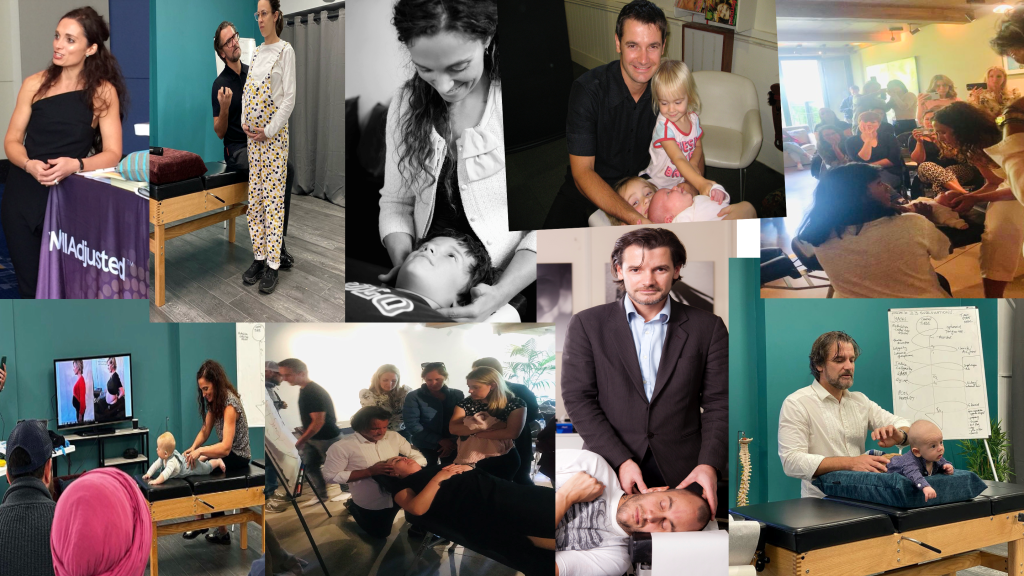For the First Time Ever — Drs Jennifer & Simon Bring Their Full 6-Module Series Live!

With over 50 years of combined experience in chiropractic practice, Drs Jennifer and Simon have trained more than 25 associates and collaborated with countless health practitioners within their multidisciplinary clinic. Their work has influenced chiropractors, students, and families across the globe — and now, for the first time ever, they’re bringing their complete 6-Module Chiropractic Mastery Series to the United States.
About Dr Jennifer Barham-Floreani
An award-winning chiropractor, bestselling author, and international speaker, Dr Jennifer Barham-Floreani is best known for her ground-breaking book Well Adjusted Babies, now read by over half a million parents, practitioners, and students worldwide.
As a mother of four boys, Jennifer brings heartfelt authenticity to her teaching — guiding families and practitioners alike with common-sense, science-backed approaches to health, pregnancy, and parenting. Her life’s work has been devoted to improving the health literacy of parents and empowering practitioners to create deeper, more effective care for the families they serve.
Since moving to Europe, Jennifer has been working with publishers on the 3rd edition of Well Adjusted Babies and developing practitioner training on methylation, genetics, and bioenergetic health — the biochemical foundation at the heart of modern wellbeing.
About Dr Simon Floreani
B.App.Sci (Chiropractic)
Dr Simon Floreani is a leading chiropractor, entrepreneur, and healthcare advocate who has spent more than three decades helping chiropractors, families, and communities thrive. As past president of the Chiropractors’ Association of Australia and the first chiropractor appointed to the Board of Directors of Allied Health Professions Australia, Simon has long been a voice for integrative, values-driven healthcare. Together with his wife, Dr Jennifer Barham-Floreani, he co-founded Well Adjusted™ and Vitality Organic Allied Health—a multi-million-dollar wellness centre in Melbourne that brings together more than 20 allied health professionals under one roof.
Across his 30-year career, Simon has employed and mentored over 35 associate chiropractors, from high-volume practitioners to parents working part-time while raising young families. His approach to leadership is one of genuine care—meeting each chiropractor where they are, rather than where someone else thinks they should be. He has run a waiting-list practice for more than 20 years, built entirely through referrals and word-of-mouth, a testament to the quality of results and depth of connection his patients experience. His practice style is gentle, non-forceful, and deeply effective—focused on helping people heal naturally and become raving fans through exceptional outcomes.
Dr Floreani and Dr Jennifer Barham-Floreani were jointly honoured with the Being of Light Award (2018)—one of only four ever presented worldwide within the chiropractic community. Simon’s other accolades include the Outstanding Service Award to Chiropractic (2013) and the Protection of the Sacred Trust Award (2020). Through his courses and mentorship, chiropractors learn how to blend clinical excellence with authenticity, empathy, and sustainable practice success—creating communities built on trust, results, and the art of true chiropractic care.

The Chiropractic Mastery Series
6 Modules | 3 Weekends | 1 Transformative Experience:
Join Jennifer and Simon for a rare opportunity to learn the clinical systems, neurological frameworks, and correction strategies they’ve refined over decades in practice.
Dates and Modules:
TOPIC:
January will be Module 1 & 2 Cranial and Cervical
🕐 Schedule: Fridays 2–6pm | Saturdays 9–5pm
📍 Venue: Impact Chiropractic, 3720 S College Ave, Fort Collins, CO
MAP: https://maps.app.goo.gl/oSgpXsYXLHDot7az7
*Prices Have Increased to cover accreditation costs.
TOPIC:
Module 3 & 4 Thoracic and Lumbar
Date and Time:
FRI 2:00pm to 6:00pm
SAT 9:00am to 5:00pm
Venue:
Impact Chiropractic
3720 S College Ave
Fort Collins, CO 80525
https://maps.app.goo.gl/oSgpXsYXLHDot7az7
*Prices Have Increased to cover accreditation costs.
TOPIC:
Module 5 & 6 Pelvic and Lovett Relationships
Date and Time:
FRI 2:00pm to 6:00pm
SAT 9:00am to 5:00pm
Venue:
Impact Chiropractic
3720 S College Ave
Fort Collins, CO 80525
https://maps.app.goo.gl/oSgpXsYXLHDot7az7
*Prices Have Increased to cover accreditation costs.
Investment Options
- Full Series (6 Modules / 3 Weekends): $2,250 *upfront (equivalent to $750 per weekend)
- Practitioners – Individual Weekends: $997 per weekend
- Practice Teams (3 or more practitioners): $850 per person, per weekend
- Students: $350 per weekend
🧠 CE credits apply.
*Please note these prices may be converted to your local currency on the shop and during checkout.
If you prepay for all 3 weekends in November you’ll receive 25% off (750 US per weekend vs 1000 US). 25% off does not apply to Practice Teams as a discount is already applied to its price.
Why Attend
These are powerful, eye-opening sessions that will transform how you understand and deliver chiropractic care. You’ll leave with a new level of clarity, confidence, and clinical skill — ready to achieve extraordinary results with your patients.
Just Some Of What You’Ll Learn
- The trophic nervous system in healing — how trophic signaling shapes tissue repair and clinical outcomes.
- Prefrontal cortex & chiropractic — the role of the adjustment through the lens of Dr Heidi Haavik’s model of sensorimotor integration.
- Why patient outcomes are shifting — biochemical individuality, modern stress loads, and what to do about it.
- Masterful take home adjusting techniques – hands on teaching
- Adjustment demonstrations and communication examples with in-house patients.
- How stress, poor methylation, and inflammation disrupt adjustment response — and how to restore adaptability so corrections hold.
- Practical clinical tools — targeted intake questions, and step-by-step case strategies you can use Monday.
- Supporting the “terrain” — when your adjustment needs a metabolic co-pilot (foundational nutrition, detox pace, and timing).
- Prenatal & pediatric hacks — simple ways to empower parents and support the next generation’s neurodevelopment.
- Methylation cycle overview — why it matters for DNA repair, inflammation, neurotransmitters, and nervous-system function, folate vs. folic acid, and why blanket supplement advice can backfire.
- Infant structure–biochemistry link — demonstrating the connection between poor methylation and structural/neurological issues (e.g., tongue tie).
- Nutrition basics for regulating methylation and energy pathways
Topics and Learnings
Module 1: Cranial Primary Subluxation
Objective:
To equip chiropractors with a clear, neurophysiologically grounded understanding of cranial primary subluxations and their relationship to brainstem overwhelm. Practitioners will learn to distinguish primary from compensatory cranial patterns, assess tone, and integrate biochemical and emotional considerations that influence neurological resilience.
This immersive module bridges manual cranial correction with modern neurobiochemistry, exploring how methylation, glutathione, vagal tone, and CSF flow impact the body’s ability to adapt and heal. You’ll learn to read the subtle language of tone and rhythm in the cranial vault — developing the art and precision to unlock “stuck” patients whose adjustments never seem to hold.
Key Topics & Skills Covered:
- The cranial nerves as messengers of brainstem regulation
- Understanding brainstem overwhelm and sympathetic dominance
- Identifying primary vs. compensatory cranial patterns
- Clinical indicators: migraines, TMJ tension, dizziness, sleep issues, feeding/swallow challenges
- Posterior vs. anterior access: balancing cranial tone through occipital, palatal, and fascial work
- Evaluating tone: high vs. low tone patterns, tacit manual responses
- Chemical, physical, and emotional barriers to correction
- Integrating methylation and neurotoxicity in cranial correction
- CSF flow, craniosacral rhythm, and prefrontal–brainstem coherence
Module 2: Cervical Primary Subluxation
Objective:
To advance chiropractors’ clinical precision in identifying and correcting cervical primary subluxations — particularly where brainstem overwhelm and autonomic dysregulation are central drivers.
This powerful weekend builds on Module 1, shifting the focus to the cervical gateway — the vital bridge between brain and body. Practitioners will deepen their understanding of vagal regulation, thyroid physiology, and sympathetic chain dynamics, learning how methylation, tone, and toxicity influence cervical stability. You’ll gain the skill to connect structural alignment with biochemical resilience, producing more lasting neurological change.
Key Topics & Skills Covered:
- The superior, middle, inferior, and stellate ganglia as regulators of cervical tone
- Neurophysiology of vagal and sympathetic balance
- Identifying primary cervical subluxations vs. compensations
- Clinical indicators: migraines, dizziness, thyroid imbalance, anxiety, postural stress
- Posterior vs. anterior cervical access:
- Atlas lift, dural release, traction vs. hyoid/thyroid fascia and carotid-sheath work
- Recognizing tone patterns (high vs. low) and autonomic feedback cues
- Physical, chemical, and emotional barriers to correction
- Airway restriction, endocrine disruptors, throat-jaw tension
- Integrating methylation, thyroid, and vagal physiology in cervical correction
- Glutathione and CSF flow — restoring brainstem–spinal rhythm and detoxification
Module 3: Thoracic Primary Subluxation
Objective:
Train chiropractors to identify and correct thoracic primary subluxations as key regulators of autonomic, respiratory, and immune tone—restoring thoracic mobility, diaphragmatic rhythm, and cardiac-vagal balance.
Key Topics & Skills Covered:
- The sympathetic chain and its control of heart, lungs, and thymus
- Identifying primary thoracic fixations vs. compensations
- Clinical signs: shallow breathing, arrhythmia, chest tightness, immune suppression
- Posterior vs. anterior (“belly-side”) protocols for respiratory and cardiac balance
- The ™ Breath Protocol for asthma, anxiety, chronic infection, and long-COVID recovery
- Thymus pumping and cardiac fascia releases for immune and blood pressure regulation
- Integrating upper-limb nerve mechanics (scapula, elbow, wrist) into thoracic corrections
- Methylation and glutathione links: cardiovascular tone, nitric oxide, immune resilience
- Restoring CSF rhythm through thoracic–sacral integration
- Case study: post-COVID breathlessness and palpitations
Module 4: Lumbar Primary Subluxation
Objective:
Equip chiropractors to recognise and correct lumbar primary subluxations as central to digestive, adrenal, and metabolic regulation.
Key Topics & Skills Covered:
- Lumbar–autonomic–organ connections: gut, liver, adrenals, and kidneys
- Primary vs. compensatory lumbar patterns
- Posterior adjustment vectors: rotational, lateral, A–P, and P–A corrections
- Belly-side organ resets: celiac, renal, adrenal, and mesenteric plexus
- Mapping organ-specific effects: reflux, bile flow, glucose regulation, cortisol rhythm
- Tone assessment: high-tone (IBS, nervous bowels) vs. low-tone (constipation, collapse)
- Emotional and chemical barriers — glyphosate, stress, trauma patterns
- Integrating methylation, PEMT, and glutathione to support gut and liver detox
- Linking lumbar motion with CSF flow and sacral pump rhythm
- Case study: IBS and adrenal collapse recovery
Module 5: Pelvic Primary Subluxation
Objective:
Help chiropractors accurately identify and correct pelvic primary subluxations affecting reproduction, continence, stability, and gait.
Key Topics & Skills Covered:
- Understanding the sacrum–SI joint–acetabulum triad and its neurological role
- Mapping the sacral plexus and pelvic autonomic ganglia
- Posterior SI and sacral adjustments for balance and gait
- Belly-side techniques: hypogastric plexus, uterine, bladder, and pelvic-floor mobilization
- Addressing reproductive health (dysmenorrhea, PCOS, infertility, endometriosis)
- Supporting bladder and bowel tone (frequency, urgency, incontinence)
- Lower-limb connections: sciatica, hip/knee/ankle stability
- Methylation and detox insights for hormonal and reproductive resilience
- Integrating pelvic and craniosacral flow for whole-body coherence
- Case study: infertility and bladder frequency resolution
Module 6: The LOVE BROTHER™ Advanced Combination Protocols
Objective:
Enable chiropractors to manage multi-regional, complex cases using an integrated Prioritisation Algorithm and combined posterior + anterior protocols.
Key Topics & Skills Covered:
- The Prioritisation Algorithm — determining the true primary subluxation
- Recognizing and sequencing multi-regional patterns:
- Abdominal migraine (visceral-vagal link)
- Pelvic ↔ TMJ axis
- Pelvic torsion → cranial jamming → knee pain
- Vagus–neck–vision–digestion chain
- Advanced posterior + belly-side combination adjusting
- Integration of methylation and detox data for pacing and safety
- Practical case clinics with outcome tracking, visit sequencing, and red flag screening
- Craniosacral integration: linking sacral pump and cranial balance
- Take-home clinician flowcharts, home programs, and patient communication tools
- Case studies: infertility with knee pain, abdominal migraine, TMJ & pelvic floor dysfunction
To Pay for your reservation, Click here.
To fill out our information sheet and complete your registration, click here.
*You may view each seminar details by using the google calendar above or clicking on the next column. You can also add seminar reminders to your google calendar using the above widget.
For More Information: If you require any further information, please email team@welladjusted.co .
What Chiropractors Say About Our Seminars:
Did I learn anything new? Absolutely! Did I learn even more than the last time? You bet! My husband and I can both easily say that this is one of the best seminars we have ever taken in our soon 20 years as DCs.,
The mix of unbelievable content and information that after presented is immediately translated into practical tips on how to use in practice - is like none other. That, mixed with a large chunk of practical, hands on work, makes this weekend worth attending not just twice but over and over again.
I cannot recommend it highly enough. It is an opportunity and a privilege for European chiropractors to pick the heads of these two brilliant minds as many times as possible. Don't put it off! Who knows how long we get to keep them for?"


"I personally gained awareness about the importance to take care of pregnant ladies and babies, this will impact our future generations. And with the Well adjusted families seminar I gained the confidence to do it and to encourage my patients to take action and bring their entire family to get adjusted. I recommend it to every vitalistic chiropractor whose mission is to make this planet a better place and to learn how to be the healthcare professional that entire families can rely on. It’s our duty to take proper care of the future generation"


These people are the real deal. Knowledgeable, well spoken, passionate, and so incredibly caring. Our entire profession is so lucky to have you! Thank you so much and I'll see you again soon!"


Besides good explanation and teaching materials, the group had enough time for "hands on" and could observe several paediatric patients treated by the instructors with expertise and love with their gentle approach of paediatric Chiropractic. I also liked the general, holistic approach to health and wellbeing which was supported by numerous tips given in the way of nutrition, vitamins etc. I took home well digested tools that could be put to practice right the fallowing week. The first feedbacks I got from patients were amazing.
I can’t wait for part 2 of the seminar and highly recommend Drs. Jen´s and Simon`s programme."





